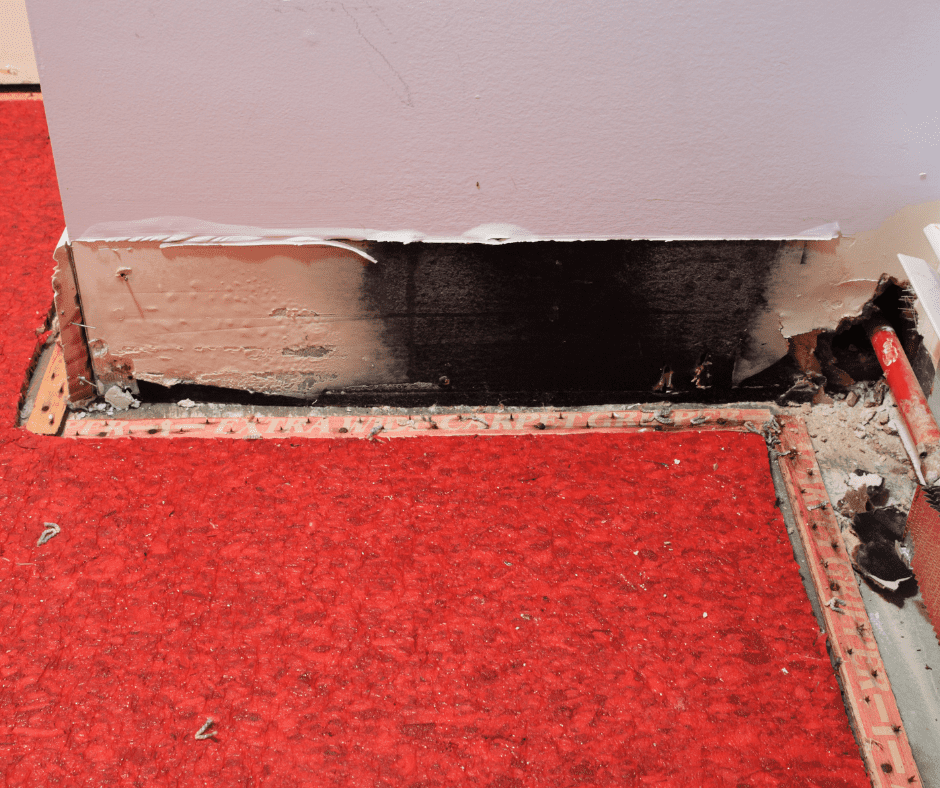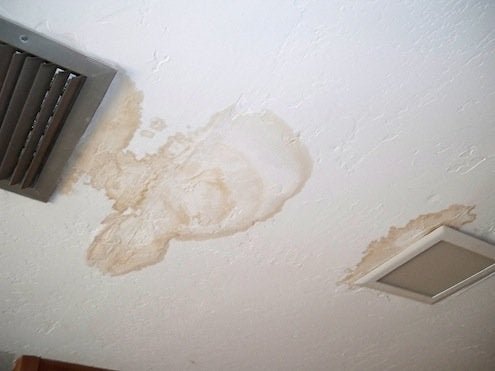What Does Water Damage Look Like?
You’ve felt it for some time now. Something just doesn’t feel right in your house. Perhaps it’s that wall that is decaying seemingly far quicker than it would in the normal lifespan of a wall. There are also some darker spots on it. And then – the smell. The sneezing. What is going on?
We understand that homeowners or business owners sometimes experience struggles in their property that they can’t pinpoint the cause of. However, in a lot of cases, you already suspect that there’s water damage in your house, it’s just that you’re not 100% sure. And that’s exactly what this article is for – to help you verify that you indeed have a water problem.
So if you’ve been wondering what does water damage look like, now you’ll find out. Let’s go!

What Does Water Damage Look Like on Walls
We’re going to start with the image above. It doesn’t look pretty but it’s definitely an accurate representation of a typical water-damaged wall.
Usually, you’ll be able to easily spot dark spots (haha) on your walls. In most cases, they’re a clear indicator that you have a leak or, even worse, mold. Mold grows in damp areas which means that water damage is almost always a direct cause of its development. Unfortunately, mold can start growing only 24 hours after a leak occurs.
Mold is something you definitely want to prevent because:
- It is a health hazard known to cause respiratory conditions
- It can also cause hefty damage to your property and your wallet
- It smells really, really bad and is an eyesore from an aesthetic standpoint (especially important for businesses holding sales meetings in their office with mold)
Mold is a sure fire way to tell that you have a bad water problem. So, if you see black spots on your walls, investigate further because mold typically grows in the shadowy, secluded parts of your property.
However, if mold is already visible on your walls and it’s too late to prevent it, call in a professional immediately because not only is there mold to remove but also a leak to detect and fix.
Those dark spots don’t always have to be mold. Sometimes your walls just get soaked and start discoloring, along with your paint starting to peel off or bubble. Additionally, try pressing those darker spots (of course, carefully and slowly) and if the walls feel soft, it’s clear as day what’s going on.
If you see peeling or bubbling paint, and there’s been no excess heat in your property, it’s probably water damage that caused it. Peeling, unlike mold a lot of times, is hard to miss, and you can always tell that there’s a problem behind those walls.
Also look for discoloration of your walls – lighter brown or beige – because sometimes there’s no mold, dark spots, and peeling paint but just brown stains.
Like this.
Pay special attention to the corners of your walls and ceilings because that’s where you’ll mostly see signs of water damage we’ve just gone over.
What Does Water Damage Smell Like
Sometimes it’s the smell that gives it away. Water damage usually has that musty and damp smell – stale and pungent – that doesn’t always necessarily have to mean that mold is there too. If you’ve noticed a bad smell in your house that makes you sneeze and maybe even causes you itchy skin and sore throat, stay on high alert.
Try to investigate further with some protective clothing that will help you not inhale that bad smell. Or just cover your nose with your hand if that’s something you’re comfortable doing. Use your own judgment if you want to inspect on your own or call in a professional but know this – inhaling that bad smell will do you no good. You may cough, sneeze, and feel dizzy.
What Does Water Damage Look Like on Floors
Now that we’ve gone over what you should see when looking up, let’s talk about what you should see when looking down. Your precious hardwood floors can get messy from water damage, and here’s how:
- Bubbling, like with walls, can be caused by a leak
- Warping where you can almost easily pick up wood tiles
- Slight or not-so-slight unevenness
Also, like with walls, look for mold, stains, and bad smells.
What Does Water Damage Look Like on Ceilings
The signs of water damage on ceilings are going to be pretty much the same like with walls – mold, bad smell, discoloration and stains, peeling paint, and misshaping. If you have a higher floor, inspect those rooms more carefully. If, instead, it’s the apartment from a different owner, notify them that there’s something going on and ask if their floors or walls have also been altered or damaged.
Other Signs of Water Damage to Look for
Different, more lowkey signs of water damage to look for include dripping sounds, unusually high water bill, worsened health conditions, increased fatigue, and unusual pet behavior – animals can be much more sensitive to mold and musty smells which can cause their health to worsen too.
What to Do About Water Damage
Have water damage? Although it is frustrating and time-consuming, you have to deal with it right away because the conditions will only worsen. Water damage won’t fix itself. Your leaking pipe won’t just tape itself and pick up the water it left off. You need to do it yourself. Or, better yet, call an expert.
International City Water Damage Restoration will help you with your water problems and leaks. Our experts respond quickly and efficiently, with great respect for your family or employees, and your property. Call us at +1 (562) 268-8779 to receive top-notch water damage repair assistance!
Our services:
The post What Does Water Damage Look Like appeared first on Water Damage Restoration Long Beach CA.
from Water Damage Restoration Long Beach CA https://ift.tt/7a8GTRh


